Click on images to enlarge

infestation (Photo: Chris Gardiner)

habit (Photo: Forest and Kim Starr, USGS)
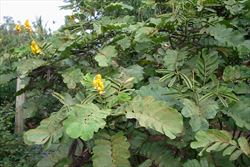
habit (Photo: Sheldon Navie)

one of the very large once-compound leaves (Photo: Sheldon Navie)

close-up of leaflets (Photo: Sheldon Navie)

elongated flower clusters (Photo: Forest and Kim Starr, USGS)
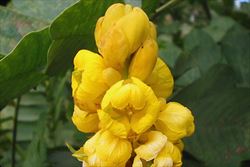
close-up of flowers (Photo: Sheldon Navie)

immature fruit (Photo: Sheldon Navie)
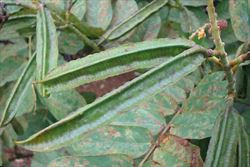
close-up of immature fruit (Photo: Sheldon Navie)

mature fruit (Photo: Sheldon Navie)

close-up of mature fruit showing wings (Photo: Sheldon Navie)

close-up of seeds (Photo: Tracey Slotta at USDA PLANTS Database)
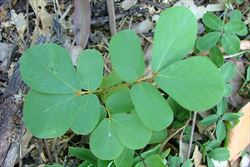
seedling (Photo: Sheldon Navie)
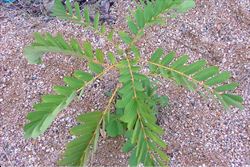
young plant (Photo: Sheldon Navie)
Scientific Name
Senna alata (L.) Roxb.
Synonyms
Cassia alata L.Senna multijuga (L.C. Richard) Irwin & Barneby (misapplied)
Family
Caesalpiniaceae (Queensland, the ACT, Victoria, Tasmania, Western Australia and the Northern Territory) Fabaceae: sub-family Caesalpinioideae (New South Wales)Leguminosae (South Australia)
Common Names
alcapulco, candelabra bush, candelabra plant, candle bush, candlebush, candlestick senna, Christmas candle, Christmas-candle, emperor's candlesticks, empress candle plant, empress-candle-plant, empress candleplant, golden candelabra tree, golden-candle senna, ringworm bush, ringworm plant, ringworm senna, ringworm shrub, ringwormbush, ringwormshrub, Roman candle tree, seven golden candles, seven golden candlesticks, stick senna, yellowtop weed
Origin
Native to tropical South America (i.e. French Guiana, Guyana, Surinam, Venezuela, Brazil and Colombia).
Cultivation
This species has been cultivated as a garden ornamental in the warmer regions of Australia.
Naturalised Distribution
A widespread species with a scattered distribution throughout northern and eastern Australia. It is most common in the coastal and sub-coastal parts of the Northern Territory and northern Queensland. Less common along the central and southern coasts of Queensland and also recorded in north-western Western Australia.
Also naturalised in tropical Africa, tropical Asia, Papua New Guinea, Mexico, south-eastern USA (i.e. Florida), the Caribbean and on several Pacific islands (i.e. the Cook Islands, Fiji, Guam, Palau, Tonga, Western Samoa and Hawaii).
Habitat
A weed of waterways, floodplains, wetlands, drainage channels, native bushland, disturbed sites, waste areas, roadsides and overgrazed pastures in wetter tropical and sub-tropical environments.
Habit
A large spreading shrub usually growing 2-3 m tall, but occasionally reaching up to 4 m in height.
Distinguishing Features
- a large shrub with very large once-compound leaves consisting of 8-14 pairs of leaflets.
- the very large leaflets (5-17 cm long and 2-5 cm wide) have entire margins and rounded tips.
- its golden yellow flowers are borne in dense elongated clusters (30-60 cm long) near the tips of the branches.
- these flowers are interspersed with yellow or orange floral bracts.
- its elongated pods (15-25 cm long) are somewhat four-angled and have papery wings.
Stems and Leaves
The thick, pithy stems are upright (i.e. erect or ascending) and occasionally branched.
The once-compound (i.e. pinnate) leaves are alternately arranged along the stems and very large (45-80 cm long and 12-25 cm wide). They are borne on stalks (i.e. petioles) 2-4 cm long and have 8-14 pairs of large leaflets. The individual leaflets (5-17 cm long and 2-5.5 cm wide) are either oblong, oval (i.e. elliptic) or egg-shaped in outline (i.e. ovate) and have entire margins. They are finely hairy (i.e. pubescent) and have rounded or slightly notched tips (i.e. obtuse, retuse or emarginate apices).
Flowers and Fruit
The golden yellow or orange flowers are borne in elongated clusters (15-60 cm long) at the tips of the stems or in the upper leaf forks (i.e. in terminal or axillary racemes). These clusters are borne on hairy stalks (i.e. pubescent peduncles) 15-30 cm long and contain numerous (20-40) densely crowded flowers. The individual flowers (2-3 cm across) are borne on short stalks (i.e. pedicels) 5-8 mm long. They are initially held within dark yellow or orange coloured bracts, but these fall off as the flowers open (i.e. they are caducous). Each flower has five sepals (9-15 mm long and 8 mm wide), five bright yellow petals (up to 20 mm long and 12 mm wide) and two stamens with relatively large elongated anthers (11-12 mm long). There are also eight small filaments (2-4 mm long) that do not have any anthers, or only have rudimentary anthers (i.e. staminodes), and an elongated ovary topped with a style and stigma. Flowering occurs mainly during late autumn, winter and spring (i.e. from May to November).
The large and elongated pods (12-25 cm long and 8-20 mm in wide) turn dark brown to black in colour as they mature and contain numerous (about 50) seeds. These pods are somewhat four-angled in cross-section and have papery wings (about 6 mm wide) along these angles. The flattened (i.e. compressed) seeds are dark brown, dark grey or black in colour (4-5 mm in size) and dull in appearance.
Reproduction and Dispersal
This species mainly reproduces by seed, although suckers can be produced when plants are damaged.
Seeds are mostly spread by water, and this dispersal mechanism is aided by the pods' ability to float considerable distances. They are also dispersed in mud attached to vehicles, machinery and animals.
Environmental Impact
Candle bush (Senna alata ) is regarded as a significant environmental weed in the Northern Territory and as an environmental weed in Queensland and Western Australia. It is also regarded as a potential environmental weed or "sleeper weed" in northern New South Wales, and was recently listed as a priority environmental weed in at least one Natural Resource Management region.
Other Impacts
Candle bush (Senna alata) can impede access to waterways and is suspected of being poisonous to livestock.
Legislation
This species is declared under legislation in the following states and territories:
- Northern Territory: B - spread to be controlled (outside of town areas only), and C - not to be introduced to the Territory.
- Western Australia: P1 - trade, sale or movement into the state prevented, and P2 - to be eradicated where found (for the entire state, except those areas constituted as townsites).
Management
For information on the management of this species see the following resources:
- the Northern Territory Department of Natural Resources, Environment and The Arts Agnote on this species, which is available online at http://www.nt.gov.au/weeds.
- the Western Australian Department of Agriculture and Food information page on this species, at http://www.agric.wa.gov.au.
Similar Species
Candle bush (Senna alata) is very similar to popcorn senna (Senna didymobotrya) and some closely related native species (i.e. Senna magnifolia and Senna venusta), which all have yellow flowers arranged in relatively dense elongated clusters. However, candle bush (Senna alata) can be distinguished from all of these species by its larger winged pods, that are four-angled in cross-section.
These species can also be distinguished by the following differences:
- candle bush (Senna alata) has very large leaves (45-80 cm long) with numerous (8-14) pairs of leaflets. The large leaflets (50-170 mm long) have rounded or slightly notched tips (i.e. obtuse or emarginate apices). Its flowers have 2 fertile stamens and are initially concealed underneath large bright yellow or orange floral bracts.
- popcorn senna (Senna didymobotrya) has large leaves (12-35 cm long) with numerous (7-18) pairs of leaflets. The relatively large leaflets (15-65 mm long) have rounded to pointed tips (i.e. obtuse to acute apices). Its flowers have 2 fertile stamens and are initially concealed underneath large purplish-brown floral bracts.
- Senna magnifolia has large leaves (up to 30 cm long) with several (4-6) pairs of leaflets. The large leaflets (50-80 mm long) have rounded or slightly notched tips (i.e. obtuse or emarginate apices). Its flowers have 7 fertile stamens and are initially concealed underneath large yellow floral bracts.
- Senna venusta has large leaves (10-35 cm long) with numerous (6-15) pairs of leaflets. The large leaflets (30-80 mm long) have rounded to pointed tips (i.e. obtuse to acute apices). Its flowers have 7 fertile stamens and are initially concealed underneath large yellow floral bracts.
Candle bush (Senna alata) is also relatively similar to sicklepod (Senna obtusifolia), coffee senna (Senna occidentalis), Java bean (Senna tora), hairy senna (Senna hirsuta), smooth senna (Senna septemtrionalis), Easter cassia (Senna pendula var. glabrata), pepper-leaved senna (Senna barclayana) and the native arsenic bush (Senna planitiicola). However, these species may be distinguished by the fact that their flowers are borne in small clusters in the upper leaf forks (i.e. axils).

